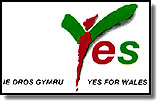Yes for Wales facts for kids
Yes for Wales! (in Welsh: Ie dros Gymru) was the name of two different groups. These groups worked to support the idea of Wales having more control over its own laws. They were active before two important votes, called referendums, in 1997 and 2011.
The 1997 Yes for Wales Campaign
The first Yes for Wales group started on February 10, 1997. Its goal was to get people to vote 'Yes' in the 1997 Welsh devolution referendum. This vote was about creating a National Assembly for Wales. This Assembly would give Wales more power to make its own decisions.
Many political parties supported the campaign. These included the Welsh Labour Party, Welsh Liberal Democrats, and Plaid Cymru. However, the Welsh Conservatives were against the idea of devolution at that time.
The Yes for Wales group wanted many people to get involved. They set up local groups all over Wales. They also managed to bring together politicians and campaigners. These people often had different ideas but worked together for this common goal.
The campaign faced strong opposition. Some members of the Conservative Party and even some from the Labour Party were against it. Even today, there can still be some disagreements about the Assembly.
Professor Kevin Morgan from Cardiff University led the 1997 Yes for Wales! campaign. Daran Hill was the national organizer.
During the campaign, Diana, Princess of Wales sadly passed away. The campaign paused for a short time. Many people wondered if this sad event would make fewer people vote. They worried it would take attention away from the important debate about Wales's future.
The 2011 Yes for Wales Campaign
The second Yes for Wales group started on January 4, 2011. This group also worked to get a 'Yes' vote in the 2011 Welsh devolution referendum. This vote was about giving the National Assembly for Wales even more power to make laws. The campaign was successful.
Roger Lewis, who was the chief executive of the Welsh Rugby Union, led this group. The First Minister for Wales, Carwyn Jones, and the Deputy First Minister for Wales, Ieuan Wyn Jones, suggested he lead it. Roger Lewis was not part of any political party. He was known for being passionate about Wales and brought a lot of experience from the business world.
Many parties supported the 2011 campaign. These included the Wales Labour Party, Plaid Cymru, the Liberal Democrats, and the Wales Green Party. The Welsh Conservative Party was officially neutral. However, all their members in the Assembly supported a 'Yes' vote. They even had a representative on the Yes for Wales Steering Committee. Other groups like Cymru Yfory, Wales TUC, and Unison also supported the campaign.
The campaign was guided by a special committee. Leighton Andrews, a Labour politician and Welsh Education Minister, chaired this committee. A small team of volunteers managed the daily work. This team included Campaign Director Daran Hill, Cathy Owens, and Lee Waters.
The campaign created over 30 local groups across Wales. In just two months, from January to March 2011, they printed and gave out 1.5 million leaflets.
See also


